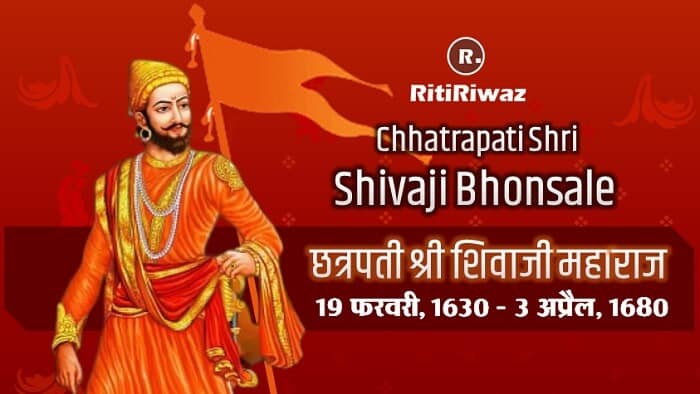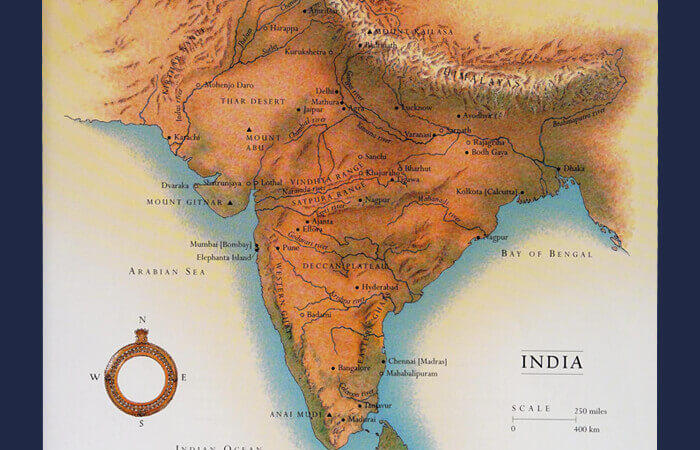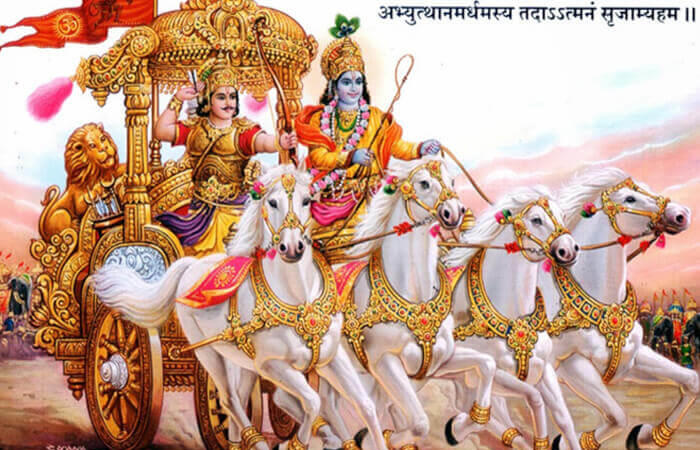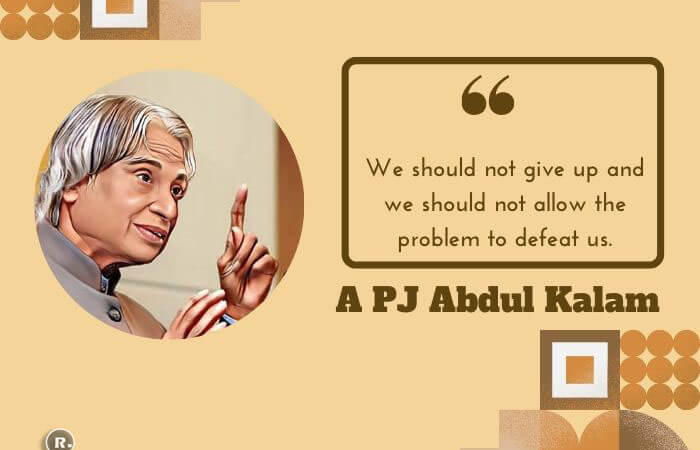Chhatrapati Shivaji Maharaj (1630-1680) Biography

Chhatrapati Shivaji was one of the bravest, intelligent and fearless Maratha ruler and was the founder of the Maratha Empire who changed the history of the country. In the year 1674 Shivaji Maharaj was crowned and received the title of Chhatrapati or ‘Chief of the Kshatriyas’ for his undaunted ability to protect them all under the safe shelter of his leadership. He is also known as the Father of the Indian Navy, as he was the first to realize the importance of having a naval force, and therefore he strategically established a navy and forts at the coastline to defend the Konkan side of Maharashtra.
Fast Facts
- Name: Shivaji Bhonsale
- Birth: 19 February 1630
- Place of Birth: Hill-fort of Shivneri
- Father: Shahaji Bhonsale
- Mother: Jijabai
- Marriage: First marriage on 16 May 1640, he was wedded 8 times
- Wife: Saibai Bhosale, Soyarabai Mohite, Putalabai Palkar, Gunwantabai Ingle, Sagunabai Shirke, Kashibai Jadhav, Lakshmibai Vichare, and Cakwarbai Gaikwad
- Children: He had 8 children Sakhubai, Ranubai, Ambikabai, Chhatrapati Sambhaji Maharaj, Deepabai, Chhatrapati Rajaram Maharaj, Kamalabai, and Rajkunvarbai
- Death: 3 April 1680
- Successor: His eldest son Sambhaji
Early life
Shivaji was born on 19 February 1630 in Shivneri Fort in Junnar village in Pune district. His father’s name was Shahaji Bhonsale and his mother’s name was Jijabai Bhosle. Shahji Bhonsale, a captain of mercenaries belonged to a Maratha family. Jijaji Bai has lost several children after Sambhaji’s birth. Shivaji was the second son of Shahji, born in the hill-fort of Shivner, Jija Bai (a daughter of the aristocratic Lukhji Jadav of Sindkhed) had prayed to the local goddess, Shiva-Bai, for the good of her expected child, and named him after that deity.
Shivaji was very close to his mother, his mother was very religious, this effect was also on Shivaji. Shivaji had a lot of knowledge of Hinduism, he wholeheartedly believed in Hinduism and did many things for Hindus. In his childhood, Shivaji studied two great Hindu epics, Ramayana and Mahabharata. These two epics influenced his life to a greater extent and made a great impression on him. Shivaji’s father got remarried and went to Karnataka, leaving son Siva and wife Jijabai with Dadaji Kond-dev, who took care of the fort. Shivaji also got the education of Hinduism from Kond-dev, along with his Kondaji taught him many things about the army, horse riding, and politics.
Shivaji was intelligent and sharp-minded since childhood, he did not take much education, but whatever he was taught, he used to learn very diligently. At the age of 12, Shivaji went to Bangalore, where he studied with his brother Sambhaji and half-brother Ekoji I. He married Saibabai from the Nimbalkar family at the age of 12. Shivaji was married 8 times the second marriage was with Soyrabai, and Shivaji as opposed to the other 6 marriages but in that era, marriage was also looked upon as an opportunity for building bonds between 2 families, who has a strong background so he had to marry with Putalabai, Sakvarbai, Sagunabai, Kashibai, Laxmibai, and Gunwantabai.
Chhatrapati Shivaji Maharaj’s battles
Shivaji fought the first war at the age of 15, he attacked and won it in the Torna Fort. After this, he also hoisted the victory flag in Kondana and Rajgarh Fort. Seeing the increasing power of Shivaji, the Sultan of Bijapur imprisoned Shahaji, Shivaji and his brother Sambhaji returned to the fort of Kondana, after which his father was released. After his release, Shahaji remained unwell and died around 1964-65. After this, Shivaji waved the flag of Maratha in the mansion of Purandar and Javeli. In 1659 the Sultan of Bijapur sent a large army of Afzal Khan against Shivaji and instructed that Shivaji should be brought alive or dead. Afzal Khan tried to kill Shivaji with diplomacy, but Shivaji killed Afzal Khan with his cleverness. Shivaji’s army defeated the Sultan of Bijapur at Pratapgarh.
Shivaji battles with Mughals
As Shivaji progressed, his enemies also increased; Shivaji’s biggest enemy was the Mughals. In 1657 Shivaji started fighting against the Mughals. At that time, the Mughal Empire was in favor of Aurangzeb, Aurangzeb pitted Shaista Khan’s army against Shivaji. He took possession of Poona and expanded the army. One night Shivaji suddenly attacked in Poona, thousands of Mughal army men were killed, but Shaista Khan escaped. After this, in 1664, Shivaji also hoisted his flag in Surat a wealthy Mughal trading center.
Treaty of Purandar
Aurangzeb did not give up and this time he pitted Raja Jai Singh and Dilir Singh of Amber against Shivaji. Jai Singh wins all the kilos that Shivaji won and defeated Shivaji in Purandarpur. After this defeat, Shivaji had to negotiate with the Mughals. The Treaty of Purandar was signed between Shivaji and Jai Singh in June 1665. Shivaji signed the treaty and according to its terms, twenty-three forts and territory with revenue of four lakh Hons (a gold coin) were to be handed over to the Moghul Emperor. Shivaji also had to agree his son, Sambhaji becomes a Moghul Sardar, and serves Aurangzeb in his court, and also to fight on the Moghul’s side against Bijapur.
Shivaji’s Arrest and escape
In 1666, Aurangzeb invited Shivaji and his son Sambhaji to the court of the Mughal Empire at Agra. Shivaji got offended by the manner of Aurangzeb as he was given the place behind the Mughals’ military commanders. Shivaji felt this behavior as an insult and stormed out of the court. The Mughals immediately arrested him and imprisoned him under house arrest. Aurangzeb rebutted that he must surrender his remaining forts before returning to Mughal service, but Shivaji along with his son escaped from the fort of Agra.
After reaching his home, Shivaji waged a war against the Mughals with new strength. It is said the Shivaji smuggled himself and his son out of Agra in large baskets, claimed to be sweets to be gifted to religious figures in the city. After this, peace prevailed between Aurangzeb and Shivaji and Aurangzeb conferred the title of raja on Shivaji and accepted Shivaji as the king. In 1674, Shivaji became the sole ruler of Maharashtra.
Coronation of Chhatrapati Shivaji Maharaj
Shivaji established the Hindu state in Maharashtra in 1674, after which he got his coronation. Shivaji belonged to the Kurmi caste, which was considered a Shudra at that time, due to which all Brahmins opposed him and refused to be crowned. Shivaji sent an invitation to the Brahmins of Banaras too, but they did not agree, then Shivaji persuaded them by bribing, and then he was crowned.
Shivaji was crowned king of Maratha Swaraj in a lavish ceremony on 6 June 1674 at Raigad fort. Shivaji Maharaj was not only an excellent warrior but also a wise ruler. He ended caste discrimination in the Maratha Empire. In India, Chhatrapati Shivaji first built the navy. After 12 days, his mother Jijabhai died, due to which Shivaji mourned. Then a Tantrik declared that the original coronation had been held under inauspicious stars, and a second coronation was needed. This second Tantrik Coronation was done on 24 September 1674. Like an independent ruler, he introduced a coin in his name. Was called “Shivrai”, and this coin was in the Sanskrit language.
Respect for all religions
Shivaji was dense in religious ideologies, he was the secular ruler and was very accommodating of all religions. The way he worshiped his religion, he also respected all religions in the same way, whose example is revealed by the feeling he had for Ramdas, able in his mind. He gave the fort of Parali to Ramdas Ji, which was later known as Sajjangad. The words of Swami Ram Das and Shivaji Maharaj are mentioned in many poems. With the ideology of protecting religion, Shivaji strongly opposed the conversion.
Shivaji kept his national flag orange, which symbolizes Hindutva. There is a story behind this, Shivaji loved Ramdas Ji very much, from whom Shivaji had received a lot of education. Once Ramdas Ji was begging in his own kingdom when Shivaji saw him and he was very unhappy with this, he took him to his palace and fell at his feet, urging him not to beg, but rather take the whole empire. Swami Ramdas Ji was very happy to see Shivaji’s devotion, but he wanted to stay away from worldly life, which he refused to be a part of the empire but asked Shivaji to run his empire well and give him his torn-off piece of cloth and said make it your national flag, it will always remind you of me and my blessings will always be with you.
Shivaji Army
Shivaji had a very large army, Shivaji used to take care of his army like a father. Shivaji used to enlist only the capable people in his army, he had so much understanding that he could run a large army well. He had trained the entire army very well, he understood everything at the behest of Shivaji. At that time different types of taxes were collected, but Shivaji was a very kind king, he did not forcibly take tax from anyone. He did a lot of work for children, Brahmins, and women. Many practices were closed. At that time, the Mughals used to persecute the Hindus a lot, forcing them to convert to Islam, at that time Shivaji came as the Messiah. Shivaji had established a strong navy, which would also deploy under the sea and protect it from enemies, at that time both the British and the Mughals were keeping a bad eye in Shivaji’s forts, hence he is called the father of the Indian Navy.
Death of Shivaji
At the age of 50, Shivaji Maharaj established his own kingdom outside the Maratha Empire. He had 300 forts and an army of one lakh soldiers in 1680. In the early 1680s, Shivaji’s health was not well. He was suffering from fever and dysentery. Suddenly, Shivaji Bhosle died on 5 April 1680. Fever and dysentery are believed to be the cause of his death. But it is also believed that his ministers were conspired to assassinate him because the ministers did not like some of Shivaji’s decisions.
Shivaji was a great Hindu protector. Shivaji had created diplomacy, under which any empire could be invaded suddenly without any prior notice, after which the ruler had to relinquish his throne. This policy was called Ganimi Kawa. Shivaji is always remembered for this. Shivaji gave a new look to Hindu society, if they had not been there, today our country would not have been a Hindu country, the Mughals would have ruled over us completely. This is the reason why Shivaji is considered God in Maratha.
The Marathas after Shivaji
Shivaji left behind a state which has odd terms with Mughals. After Shivaji’s death, his son, Sambhaji became king of the Marathas. He continued to attack the Mughal territories. Aurangzeb launched an offensive in the South to capture territories held by the Marathas. Shahu, a grandson of Shivaji and son of Sambhaji, was kept prisoner by Aurangzeb. After Aurangzeb’s death in 1707, Shahu, the son of Sambhaji (and grandson of Shivaji), was released. The next ruler was Shahu in whose reign the Peshwas rose to power.






